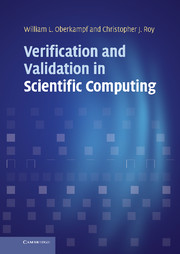Book contents
- Frontmatter
- Contents
- Preface
- Acknowledgments
- 1 Introduction
- Part I Fundamental concepts
- 2 Fundamental concepts and terminology
- 3 Modeling and computational simulation
- Part II Code verification
- Part III Solution verification
- Part IV Model validation and prediction
- Part V Planning, management, and implementation issues
- Appendix Programming practices
- Index
- Plate Section
- References
3 - Modeling and computational simulation
from Part I - Fundamental concepts
Published online by Cambridge University Press: 05 March 2013
- Frontmatter
- Contents
- Preface
- Acknowledgments
- 1 Introduction
- Part I Fundamental concepts
- 2 Fundamental concepts and terminology
- 3 Modeling and computational simulation
- Part II Code verification
- Part III Solution verification
- Part IV Model validation and prediction
- Part V Planning, management, and implementation issues
- Appendix Programming practices
- Index
- Plate Section
- References
Summary
The phrases modeling and simulation and computational simulation are becoming prevalent in a wide variety of technical, economic, governmental, and business activities (Schrage, 1999). Indeed, the phrases are becoming so common that one is even beginning to see them in the mass media. What do they mean? These phrases can have a wide variety of meanings depending on the field and the context. Here, we are concerned with the fields of the physical sciences and engineering. By examining the fundamentals of modeling and simulation (M&S) and scientific computing, our goal is to see the similarities in model formulation and computational issues across a wide range of physical systems. Our approach to scientific computing emphasizes the similarities that exist in mathematical form and structure of models in many technical disciplines. Then a framework, an overarching structure, is constructed for either attacking more detailed features of the system or for attacking more complex systems. Commonly, more complex systems involve coupling different types of physical phenomena, incorporation of additional elements from the system or the surroundings, and effects of human intervention in the system. Similarities in model formulation issues exist because many of the model properties are not determined by their physical nature, but by their mathematical structure, the interaction of the system with the surroundings, and the similarity in the nature of the system responses.
Many of the difficult issues that must be dealt with in verification, validation, and uncertainty quantification (VV&UQ) can be traced back to ambiguities and inconsistencies in the model formulation, the mapping of continuum mathematics models to discrete mathematics models, and vague or improper characterizations of uncertainties. This chapter deals with many of those issues by examining the fundamentals of M&S.
- Type
- Chapter
- Information
- Verification and Validation in Scientific Computing , pp. 83 - 144Publisher: Cambridge University PressPrint publication year: 2010
References
- 2
- Cited by



